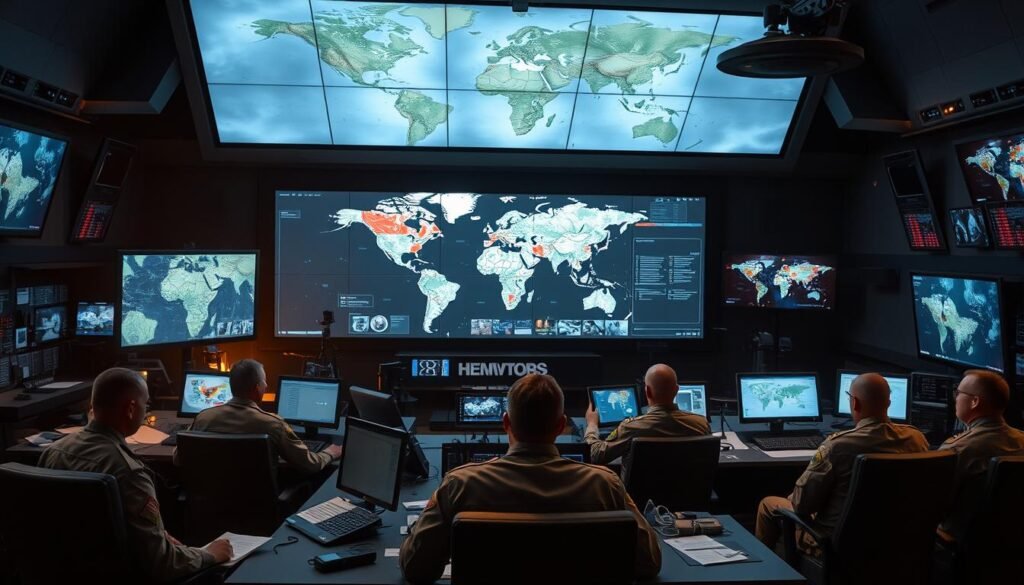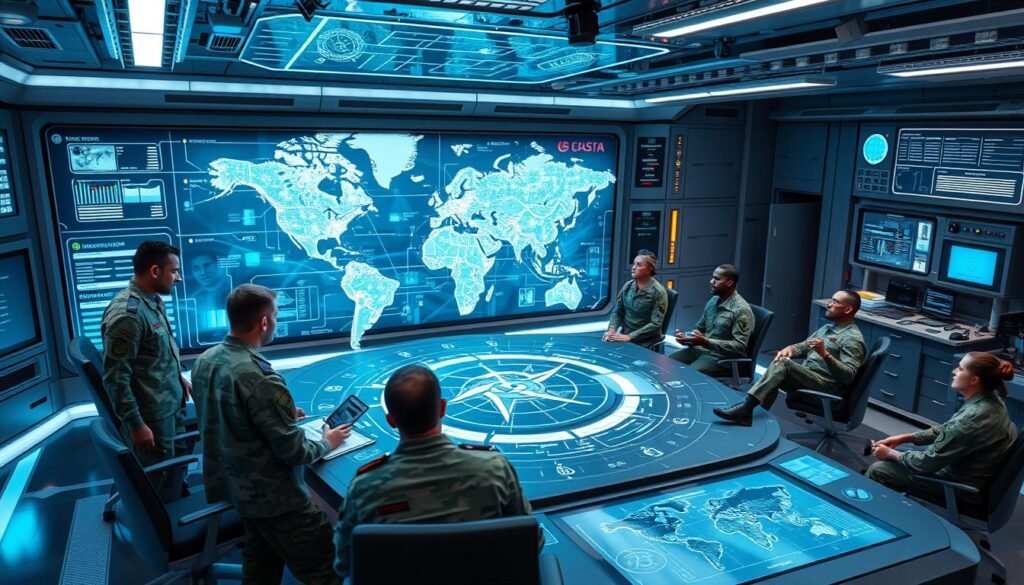The United States’ defense policy is key to its national security. It sets the goals, priorities, and military strength needed to protect the country at home and abroad. Knowing how defense policy impacts national security is crucial in our complex world.
Key Takeaways : Defense Policy
- Defense policy outlines the strategic goals and priorities to maintain national security.
- It defines the military capabilities, readiness, and resources required to address security threats and challenges.
- Effective defense policy aligns with broader foreign policy objectives to safeguard the nation’s interests.
- Continuous evaluation and adaptation of defense policy is necessary to address emerging security threats and geopolitical shifts.
- Coordinated efforts across government agencies are essential for implementing a comprehensive national security strategy.
Understanding National Security Strategy
The National Security Strategy (NSS) is a key document. It outlines how the United States will protect its interests and tackle global challenges. Congress requires it. It acts as a guide for the executive branch to share its vision and how it plans to use American power for security goals.
Purpose and Mandate of the National Security Strategy
The NSS must be sent to Congress every year. This is due to the Goldwater-Nichols Department of Defense Reorganization Act of 1986. It details the administration’s top security priorities, such as:
- Protecting the homeland and securing the American people
- Promoting economic prosperity and global competitiveness
- Advancing American influence and leadership on the world stage
- Fostering a favorable global environment for the United States
Evolution of National Security Strategy Over Time
Since 1987, the first NSS under President Ronald Reagan, the strategy has changed with the world and national priorities. Each administration, from George H.W. Bush to Joe Biden, has made its mark. They’ve updated the NSS to meet new challenges and chances.
The NSS is vital for coordinating national power. This includes diplomatic, informational, military, and economic efforts. It helps protect the United States’ security and boost its global influence.
Key Components of Defense Policy
The National Defense Strategy (NDS) is a key guide for the U.S. military. It sets out the main goals and priorities for our defense. This plan helps the Department of Defense work with the overall national security strategy.
Strategic Objectives and Priorities
The NDS has three main goals for defense policy:
- Deter aggression and defeat potential adversaries
- Strengthen alliances and partnerships
- Ensure the U.S. military’s technological advantage
To meet these goals, the strategy focuses on several areas. These include modernizing the military, improving readiness, and investing in key areas like cybersecurity and space operations.
Military Capabilities and Readiness
The NDS also stresses the importance of having a strong and ready military. It aims to ensure the right mix of people, equipment, and training. This way, the U.S. military can project power and sustain operations around the world.
Regular checks on the military’s readiness and modernization are key. They help make sure the military can carry out its strategic goals.
| Defense Policy Element | Description |
|---|---|
| Strategic Objectives | Deter aggression, strengthen alliances, maintain technological edge |
| Military Priorities | Force modernization, readiness, critical capabilities |
| Force Posture | Global presence, power projection, sustainment |
| Readiness Assessments | Personnel, equipment, training, deployment |
By matching the military’s capabilities with the NDS’s strategic priorities, the U.S. defense policy works to protect national security and keep the world stable.
Defense Policy and National Interests
Defense policy is key to keeping a nation safe. It protects its territorial integrity and sovereignty. It also keeps its economic security and trade interests safe. The National Security Strategy and National Defense Strategy show how the government and Department of Defense will defend these interests. They do this against changing geopolitical rivalries, emerging threats, and shifting global conditions.
Protecting Territorial Integrity and Sovereignty
A strong defense policy is vital for a strong military. It helps stop aggression and keeps the country’s territorial integrity and sovereignty safe. This means having advanced military capabilities, strong alliance networks, and using diplomacy, economics, and security to handle threats.
Safeguarding Economic and Trade Interests
In today’s world, defense policy also protects a nation’s economic security and trade interests. Defense efforts create a security framework that keeps goods, services, and investments flowing freely. This keeps the country prosperous and competitive in the global economy.
| Key Objective | Relevant Defense Policy Measures |
|---|---|
| Territorial Integrity and Sovereignty |
|
| Economic Security and Trade Interests |
|
By linking defense policy with protecting these key interests, governments can boost their security framework. They can also improve their global competitiveness. This helps them deal with geopolitical rivalries and emerging threats.
“The primary purpose of our national defense is to protect the United States, our citizens, and our vital interests from attack or coercion.”
Defense policy
Effective defense policy needs a mix of modernizing the military and building strong alliances. The U.S. must keep investing in new military modernization and technology innovation. This helps stay ahead and tackle new threats.
Key to this is creating advanced weapons systems, improving intelligence capabilities, and boosting cybersecurity. By leading in military tech, the U.S. can show strength worldwide. This helps prevent conflicts and keeps regions stable.
Strengthening Alliances and Partnership Networks
Defense policy also focuses on building strong alliances and partnership networks. Working closely with allies lets the U.S. spread its influence, tackle common security concerns, and manage regional issues better.
Together, the U.S. and its partners can improve deterrence and stop conflicts before they start. This teamwork makes the U.S. stronger and helps create a safer world. It also supports America’s key national interests.
| Military Modernization Initiatives | Alliance and Partnership Strengthening |
|---|---|
|
|
By balancing military modernization and alliance building, U.S. defense policy protects the nation’s interests. It also helps the U.S. lead globally and supports a safer world.
Emerging Challenges and Threats
The world is facing many new challenges and threats that affect both national and global stability. Key concerns include growing geopolitical rivalries and great power competition. Also, the rise of transnational threats and non-state actors is a big worry.
Geopolitical Rivals and Great Power Competition
China and Russia are trying to change the world order and grow their influence. This strategic competition is making tensions high and could lead to more conflict in important areas. Places like the South China Sea and Eastern Europe are seeing these geopolitical rivalries cause big security challenges. We need a strong defense plan to deal with these issues.
Transnational Threats and Non-State Actors
- Terrorist groups, cybercriminals, and other non-state actors are making asymmetric warfare and global instability more common.
- These transnational threats go beyond borders, needing a team effort to fight emerging threats and protect important places and things.
We need to update our defense strategies to tackle these complex issues. We should use a mix of military, diplomatic, and strategic steps to keep the U.S. safe and the world stable.
“The world is becoming more dangerous, with the return of great power rivalry and the proliferation of transnational threats that defy traditional borders and boundaries.”
Balancing Defense Priorities
Making a good defense policy means balancing different needs and using limited resources well. This means choosing where to spend money on things like military tech, training, and other important areas. It’s a tough job that requires making hard choices.
The National Defense Strategy shows how the Department of Defense plans to use its budget. It aims to keep the U.S. armed forces ready and strong. It’s key for the U.S. to lead and protect its interests around the world.
Resource Allocation and Defense Spending
Planning the budget and using resources wisely is vital. It helps strengthen the military and improve its abilities. The Pentagon must decide where to spend money carefully, considering different priorities.
- Modernizing weapon systems and technologies
- Keeping the military ready and trained
- Improving spy and reconnaissance abilities
- Creating new ways of fighting and thinking
- Keeping up the industrial base and supply chains
| Defense Priorities | 2023 Budget ($ Billions) | 2024 Budget ($ Billions) | Percent Change |
|---|---|---|---|
| Procurement | 144.0 | 150.2 | 4.3% |
| Research, Development, Test, and Evaluation | 130.1 | 145.1 | 11.5% |
| Operation and Maintenance | 281.8 | 298.3 | 5.9% |
| Military Personnel | 168.4 | 172.7 | 2.6% |
These budget choices affect the U.S. military’s strength and readiness. They help meet the country’s security goals.
“Balancing defense priorities is a complex and dynamic process that requires careful analysis, foresight, and tough choices to ensure the United States maintains a strong and responsive military force.”
Coordination and Integration
Effective defense policy needs close work with foreign policy and a whole-government approach. The National Security Strategy and National Defense Strategy must work together. This creates a clear plan to protect U.S. interests and tackle global security issues.
This defense policy coordination means improving interagency cooperation and intelligence sharing among agencies like the Department of Defense, Department of State, and Department of Homeland Security. By integrating defense policy with other national security efforts, the U.S. can use all its power to deter aggression, manage crises, and advance strategic interests worldwide.
Aligning Defense and Foreign Policy
Linking defense policy and foreign policy is key for a strong national security framework. This policy coherence makes sure military, diplomatic, and other efforts work together. They help achieve common goals.
Strengthening Interagency Cooperation and Intelligence Sharing
Improving interagency cooperation and intelligence sharing is vital for threat mitigation and crisis response. A whole-of-government approach lets the U.S. use the skills and resources of different agencies. This helps in developing and implementing comprehensive solutions to national security issues.
The strategic integration of defense and foreign policy, along with strong interagency coordination and intelligence sharing, helps the U.S. effectively navigate the complex geopolitical landscape and protect its vital interests.
Also Read : How Geopolitics Affects World Markets
Conclusion
Defense policy is key to keeping America safe and strong on the world stage. The National Security Strategy and National Defense Strategy offer a full plan to keep the U.S. leading, build strong alliances, and tackle new threats. In a world filled with intense competition and global crises, having a strong defense policy is vital for the U.S.
To stay strong, the U.S. must keep updating its military, strengthen strategic partnerships, and link defense with broader foreign policy goals. This way, the U.S. can keep being a key source of stability and security worldwide. The ongoing changes in defense policy and a flexible strategy will help the U.S. lead globally and protect its interests.
As the U.S. deals with the complex issues of defense policy and national security, a detailed and connected approach is needed. This approach will help the U.S. stay a top world power and a champion of peace, wealth, and democracy globally.
FAQs
Q:What is the National Security Strategy (NSS)?
The National Security Strategy (NSS) is a report made by the executive branch. It outlines the national security vision and how the U.S. will use its power to meet security goals. It talks about international interests, commitments, and objectives, along with the defense capabilities needed to protect against threats.
Q:What is the National Defense Strategy (NDS)?
The National Defense Strategy (NDS) focuses on how the Department of Defense will help achieve NSS goals. It explains how the DoD will keep the world safe and prosperous. The NDS is updated every four years and covers the global strategic environment, force posture, and the U.S. role in global security.
Q:How does defense policy play a critical role in protecting a nation’s vital interests?
Defense policy is key to protecting a nation’s vital interests like its territory and economy. The National Security Strategy and National Defense Strategy show how the U.S. government and Department of Defense will keep these interests safe. They address geopolitical rivalries, emerging threats, and global changes.
Q:What are the key components of effective defense policy?
Effective defense policy means modernizing military forces and technologies to stay ahead. It also means building strong alliances to increase global influence, deter aggression, and tackle shared security issues.
Q:What are the emerging challenges and threats in the global security landscape?
The world faces many new challenges and threats, like growing rivalries and threats from non-state actors. Effective defense policy must tackle these issues with a mix of military, diplomatic, and strategic actions. This helps protect the U.S. and its allies.
Q:How does defense policy need to be coordinated and integrated with broader foreign policy objectives?
Defense policy must work closely with broader foreign policy goals and government efforts. The National Security Strategy and National Defense Strategy need to be in line to protect U.S. interests and tackle global security challenges. This means improving cooperation and sharing information among agencies.
Source Links
- https://history.defense.gov/Historical-Sources/National-Security-Strategy/
- https://history.defense.gov/Historical-Sources/National-Defense-Strategy/
- https://www.whitehouse.gov/wp-content/uploads/2022/10/Biden-Harris-Administrations-National-Security-Strategy-10.2022.pdf










